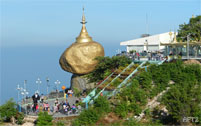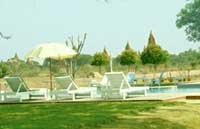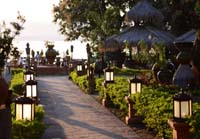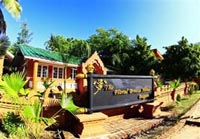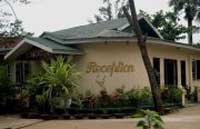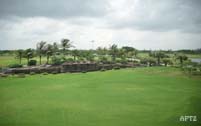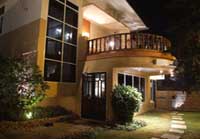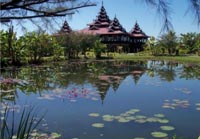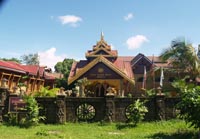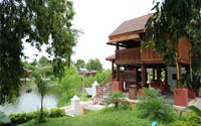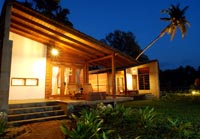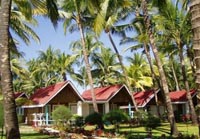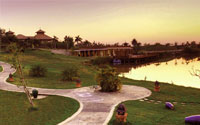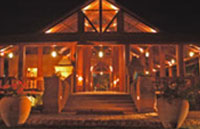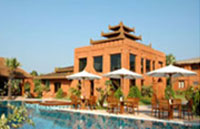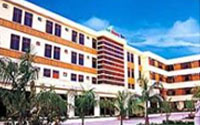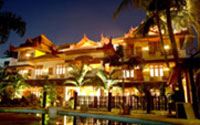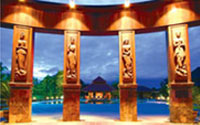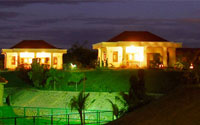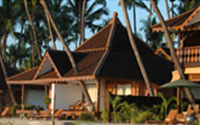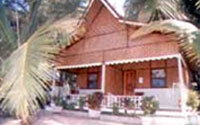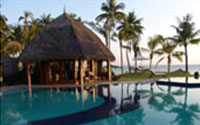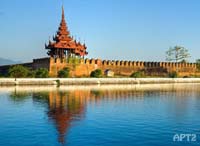
Mandalay, the last Royal Capital of Myanmar Kingdom was founded by King Mindon in 1857. King Mindon is the King who is remembered and honored by his magnificent idea to keep the Buddhist Scripture in stone slabs which remain up to day and known as world's biggest book (Ref. Greenwich World's Record). As per records, King Mindon convened 2400 monks for 6 months to deliberate and agree to get one unique Authorized Version. It took eight years to carve the marble slabs with 5000 Masonry worker. The completion work done of Row after row of white pagodas each contains a marble slabs inscribed on both side the Tripitaka (Buddhist Scriptures).
King Mindon also held the completion ceremony by reading the whole work was read aloud without a Pause.City was founded at the foot of Mandalay Hill where has the legend that Buddha visited and prophesied.
Geographically, City is surrounded and bordered by hill connecting with Shan Plateau in the east, Ayeyarwaddy River in the west, Dote Hta Waddy or Myitnge River in the South, Matayar River in the North. Mandalay has the Royal palace built with equally square shaped Moats filled with water in all seasons along the walls. The Mandalay Palace and its walls, gates, moats and bridges can be seen till today even though the whole magnificent Palace was destroyed by fire and also by bombs of Allied Troops during the World War II.
Being as the Royal Capital, Mandalay is rich in Culture heritage of ancient Myanmar Kingdoms especially in Arts & Crafts - Tapestry, Gold-leave making ( In these workshops, you will see the ancient ways challenging against modern methods and technology amazingly to make 0.001milimeter thick gold leave from 24 caret solid cubes of gold using deer leather, iron hammer, stone foot, water clock and so on, Traditional Dancing and Music instruments, Bronze Moldings and Coppersmith, Silk Weaving, Gold embroidery and Glass Mosaic.
Mandalay is still leading and also an unique place for Silk Weaving - Lun Yar Kyaw Achake ( A Classic Silk weaving in unique traditional way of design and way of weaving. Myanmar people are still so proud of wearing Lun Yar Kyaw Achaik at Ceremonies. Normally, Lun Yar Kyaw Achake is expensive and priced depending on the different shuttles they have to use during making it. Meaning of Lun Yar Kyaw is more than hundred of shuttles. It takes months to finish one piece - 2 yards of Lun Yar Kyaw. High class people used to order months in advance to get the good design and color.
Mandalay is also standing as a leading City where the country's famous Traditional Dance and Music Artist were emerged. In Religion, most Buddhist Monks reside in Mandalay as Mandalay is the heart of Religion and Culture of Myanmar. Centre of the Country make the City an important place like junction point or a hub and it connects to all parts of the country and to China and India in various ways of transportation. After more than 150 years, Mandalay remains as upper country's main gateway and also a commercial city. Mandalay is the populated city in the country and it has been filled with Migrants since the King's time. Most of the Migrants are from Yunan Province, China. Mandalay International Airport, Second Largest Airport in Myanmar has direct flight routes to China and Thailand. At Mandalay Royal Palace, you can find all the amazing Buildings such as an Old Watched Tower and Myanmar architectural wooden complex with highly ornamented and gold - gilded halls used by Myanmar Kings and also the Swimming Pool that High Ranking Royal Family used and the Glass Palace that is build and used by King Thibaw (the Last King of Kongbaung Dyanasty).
The Tomb of King Mindon founder of this Magnificent City is still existed at Mandalay Royal Palace.
Places to see
-
Mandalay Hill
-
Mandalay Palace
-
Shwenandaw Monastery ( Golden Palace Monastery)
-
Maha Muni Pagoda
-
Kuthodaw Pagoda
-
Kyauktawgyi Pagoda
-
Buddha's Replica Tooth Relic Pagoda
-
Atumashi Monastery ( The Incomparable)
-
Thudamhar Zayat ( Public Houses for preaching the Doctrines)
-
Sandar Muni
-
Ma Ha Law Ka Marazane
-
Gold Leave Making Work Shop
-
Silk - Lun Yar Kyaw Achaik Weaving loon work shops
-
Stone Sculpture, Marble Work, Stone Scripting, Stonemasons
-
Tapestry work shop
-
Gold embroidery work shops
Places Around the City :
Amarapura, Innwa ( Ava), Sagaing, Mingun, Monywa, Pyin Oo Lwin @ May Myo
Amarapura
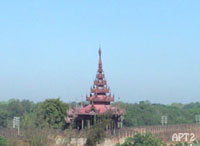
Amarapura was the Capital City during Konbaung Dynasty. It was founded by King Bodawpaya in 1783. Meaning of Amarapura is Land of no death, in other word, Land of immorality. King Bodawpaya is also well- known for his dedicated four Great Nobel deeds. The City was founded when founder King Bodawpaya moved the Capital from Innwa (Ava). However, Amarapura was moved back to Innwa in 1823, during the time of King Bagyidaw ( Grandson of King Bagyidaw) and moved back to its place to Amarapura in 1837 when King Tharrawaddy - successor of King Bagyidaw and remained as Capital until King Mindon founded Mandalay. That is also the reason; Amarapura is called today Myo Haung (Old City). It is also known as Taung Myo (Southern City). Amarapura is located on the bank of Ayarwaddy (Irrawaddy) River and closer to Mandalay about 45mins to 1 hour drive. City is surrounded by waters - Taung Thaman Inn (Lake) where Boats and even ships can reach to the City Walls when the high tide of water days, Dote Htar Waddy River, Tat Thay Inn.
*** As per the records, in Myanmar Month Warkhaung of Myanmar Era 1217, the British Delegation lead by Mr. Fayer had reached near to Amarapura Royal Palace by his fully equipped ship floating through the Taung Thaman Inn. The tombs of King Bodawpaya, King Bagyidaw and King Tharrawaddy still exist. Tomb of King Bodawpaya is located at the north of Shwezaga Pagoda and King Bagyidaw's tomb can be seen at the east of Pyatthat Kyi Village where you will see tomb of King Tharrawaddy at the north of Palace site near the service staff quarter of Electrical and Mechanical Corp II.
The tomb of King Bodawpaya and King Bagyidaw are built in white washed brick mausoleums in Zedi ( Chedi) type enshrining the cremated bones of Kings. The tombs have inscriptions in English and Myanmar. The tomb of King Tharrawaddy is also in Zedi shape enshrining his bones. Amarapura is very famous for the Silk Weaving Industry producing proudly the Traditional Textile for Royal and Cultural Ceremonies. This place still remains as the main production area.
U Bein Bridge
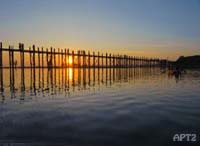 A Longest Live Teak Bridge in the world and proudly maintains it's role with the uniqueness of A Two Centuries Old, Three Quarter of a mile long Teak Bridge crossing the Taung-tha-man Inn ( Lake) is one of the most amazing and attracting place and it is a place that you must see not to feeling regret. The name - U Bein is given after the name of the donor U Bein who was a clerk of the Mayor of Amarapura and brother in law of King Bagyidaw (brother of Queen Mae Nu). All the Teaks used for the bridges were taken from the old planks and post of dismantled houses of Innwa and Sagaing. It took two years to be finished. The bridge has been used constantly and continuously by people since it was opened in 1851. It is amazing to see the bridge has been used for over 159 years and it is still performing well. You will find at some points, where were used as drawbridges to allow the royal barges and war boats to go under the bridge to go out to the Ayeyarwaddy River in Old days when Amarapura was a King's Capital.
A Longest Live Teak Bridge in the world and proudly maintains it's role with the uniqueness of A Two Centuries Old, Three Quarter of a mile long Teak Bridge crossing the Taung-tha-man Inn ( Lake) is one of the most amazing and attracting place and it is a place that you must see not to feeling regret. The name - U Bein is given after the name of the donor U Bein who was a clerk of the Mayor of Amarapura and brother in law of King Bagyidaw (brother of Queen Mae Nu). All the Teaks used for the bridges were taken from the old planks and post of dismantled houses of Innwa and Sagaing. It took two years to be finished. The bridge has been used constantly and continuously by people since it was opened in 1851. It is amazing to see the bridge has been used for over 159 years and it is still performing well. You will find at some points, where were used as drawbridges to allow the royal barges and war boats to go under the bridge to go out to the Ayeyarwaddy River in Old days when Amarapura was a King's Capital.






